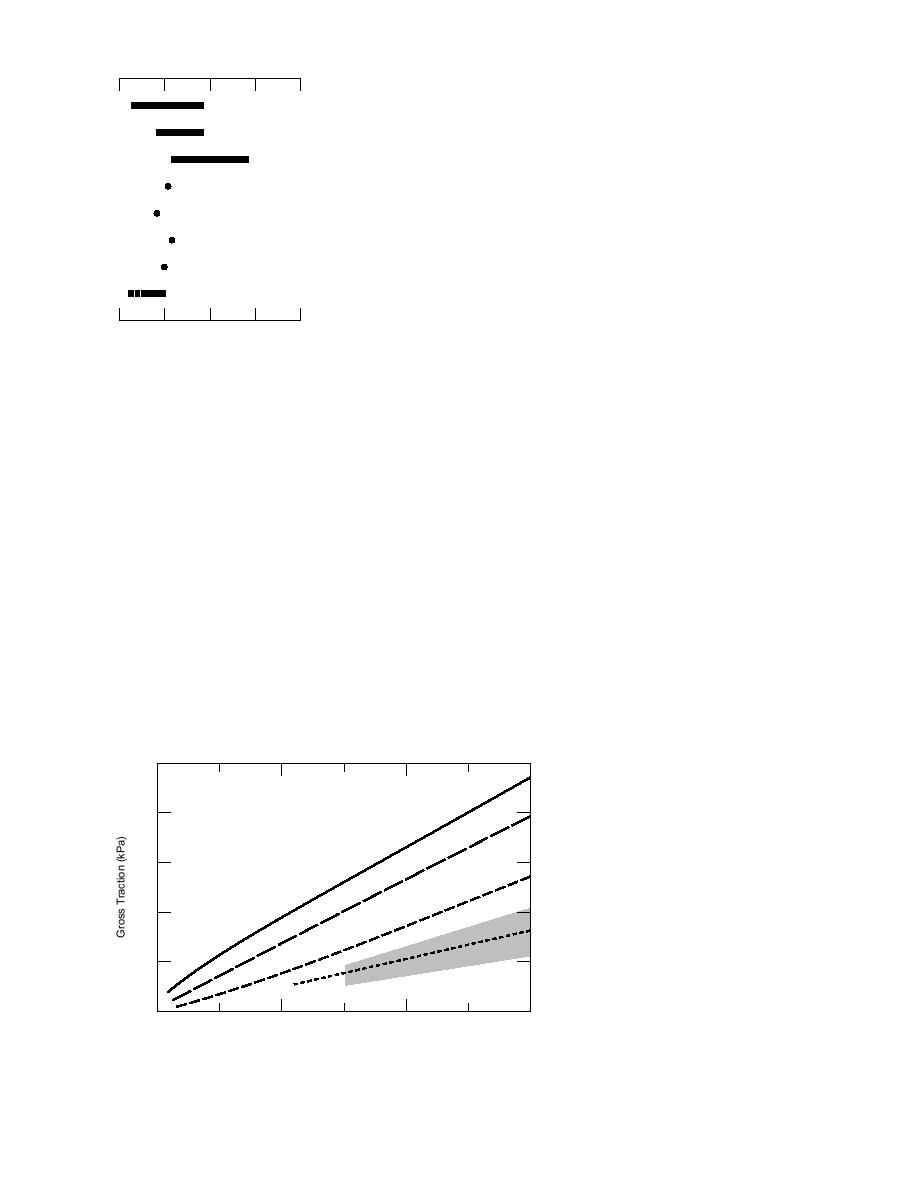
For wheeled vehicles:
ρ0 < 0.15 Mg/m3
Light snow over smooth ice (Shoop 1993b)
"
1) If sinkage ≥ wheel radius, multiply
"Rough" ice (Shoop 1993b)
resistance by 1.5.
2) If sinkage ≥ ground clearance, add
B ough" ice (Blaisdell 1993b)
R
1.5 to multiplier above.
Buffed ice at 3C (Blaisdell & Borland 1992)
ρ0 ≥ 0.15 Mg/m3
uffed ice at 10C (Blaisdell & Borland 1992)
1) If sinkage ≥ (0.666 wheel radius)
but less than wheel radius, multiply
" ice (SME 1993)
resistance by 1.5.
2) If sinkage ≥ wheel radius, multiply
H ule of thumb"
R
resistance by 2.5.
ighway travel (Clark 1982)
3) If sinkage ≥ ground clearance, add
1.5 to multipliers above.
0
0.1
0.2
0.3
0.4
Traction Coefficient for Ice
For tracked vehicles:
Figure 9. Vehicle traction on ice.
ρ0 < 0.15 Mg/m3
1) If sinkage ≥ ground clearance, multi-
tions of the undercarriage may drag in the snow
as the result of greater sinkage. In very deep snow,
ply resistance by 2.5.
ρ0 ≥ 0.15 Mg/m3
even the front face of a vehicle may be "plow-
1) If sinkage ≥ ground clearance, multi-
ing" snow.
Lacking quantitative data for motion resis-
ply resistance by 4.0.
tance in deep snow, we based our initial model of
resistance in deep snow on a combination of ana-
In formulating these guidelines, we took ground
lytical considerations and our collective obser-
clearance to be the height above ground of the
vations of the behavior of vehicles operating in
lowest major component of the undercarriage of
deep snow conditions. Our model of resistance
a vehicle, measured while it is parked on a firm
in deep snow uses "multipliers" applied to the
surface. Our experience suggests that small, or a
low number of, protuberances generate little ad-
shallow snow resistance expression (eq 3). These
ditional resistance (Richmond, in prep.). How-
multipliers were chosen to represent the signifi-
ever, the NRMM/CAMMS database lists ground
cant increase in resistance experienced when snow
clearance as the distance from the lowest compo-
is being pushed forward by the near-vertical face
nent to the ground. Therefore, our model will
of the tire when sinkage is large. For tracked ve-
yield conservative output (it will err on the side
hicles the concern is primarily interference with the
of overprediction for Rterrain).
undercarriage. The multipliers are as follows:
100
w
no
dS
80
rbe
tu
dis
Un
w
o
Sn
ed
ck
60
Pa
e
r Ic
ve
wO
40
Sno
20
Ice
CIV on
0
Figure 10. Vehicle traction on snow
0
100
200
300
and ice.
Normal Stress (kPa)
8



 Previous Page
Previous Page
